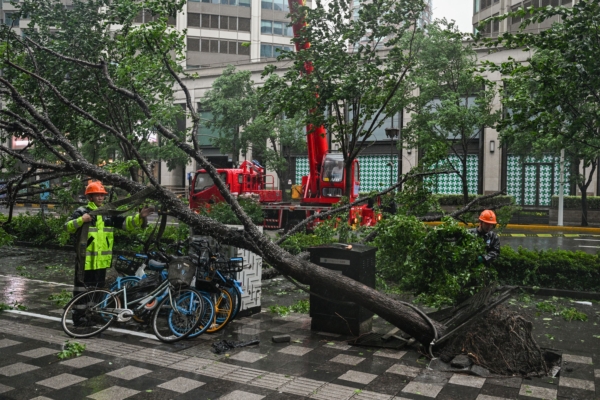Typhoon “Beibei Jia” made landfall in Pudong, Shanghai in the early morning of Monday, September 16th, marking the strongest typhoon to hit Shanghai in 75 years. Online videos showed trees being blown down in some schools and residential areas, with vehicles damaged. A local university student told reporters that walls cracked at his friend’s home in Nanhui, forcing them to seek shelter in the basement to avoid the typhoon.
According to Weather Network reports, after “Beibei Jia” made landfall, the maximum gust in Pudong reached level 10, while in Baoshan, Shanghai it reached level 11. In a three-hour period, accumulative rainfall in Hui Nan, Pudong, reached 80.2 millimeters, 73.6 millimeters in Fengxian, 52 millimeters in Pudong, 38.2 millimeters in Minhang, and 32.2 millimeters in Xujiahui.
On the morning of the 16th, a reporter from “Look News” at the seaside on Nangang Avenue mentioned that they had to squat halfway and brace themselves, or else the wind would blow them away if they stood straight.
Some netizens in Shanghai expressed fear due to the severe weather conditions: “The wind and rain outside are intense now, I am a bit scared just hearing the howling wind from inside my home.” Another said, “When will it pass? I am worried about the windows, and occasionally have to wring water from the towels placed in the window gaps.”
Online videos and images showed trees and electric bicycles in school campuses and residential areas being toppled by strong winds. In some areas, fallen trees crashed onto parked cars, while in one instance, a motorcycle was hit by a falling tree and caught fire, prompting onlookers to use fire extinguishers. Additionally, some streets were flooded, with water reaching up to ankle-deep levels.
On the morning of the 16th, a resident of Yangpu District in Shanghai, Ms. Wu, mentioned that the wind had slightly subsided compared to the previous night but was still strong, accompanied by moderate rainfall. Tree branches in the residential area were swaying violently, keeping residents indoors for safety.
She added, “I have a friend who lives close to where the typhoon made landfall. When he went out this morning, his umbrella broke as soon as he stepped outside, and his glasses were blown away and lost. It scared him, so he rushed back home. In the city center where I am, things are a bit better.”
Shanghai netizen “Shuiping Miaomiao 520” shared, “The typhoon knocked down my electric scooter, and I feel like the tree by my door is about to fall, leaning dangerously.”
A resident of Jing’an District in Shanghai, Ms. Li, informed reporters, “We live on the fourth floor, and the wind is very strong, around level 6 to 7. Rain is blowing into the house, walking on the road is exhausting due to strong winds. Right now, the rainfall isn’t too heavy, and no trees have fallen yet.”
A university student in Sheshan Town, Songjiang District in Shanghai, described it as the largest typhoon he had ever experienced. He mentioned that walls at his friend’s home in Nanhui had cracked and they had retreated to the basement for safety.
Before the landfall of “Beibei Jia,” on the evening of the 15th, the sky over Shanghai suddenly displayed a purple-red color. This student mentioned that discussions in social groups were buzzing, with some waking up startled by the unusual sky.
Chinese media reported that due to the typhoon’s impact, as of midnight on the 16th, at least 414,000 people had been evacuated in Shanghai. Shanghai Disneyland announced closure on the 16th, and several tourist spots canceled Mid-Autumn Festival-related activities. Additionally, some high-speed rail services were suspended, and flights were canceled.
According to the Weather Network, as of 12 p.m. today, the center of Typhoon “Beibei Jia” was located at Kunshan in Suzhou, with its next target set for Wuxi.

